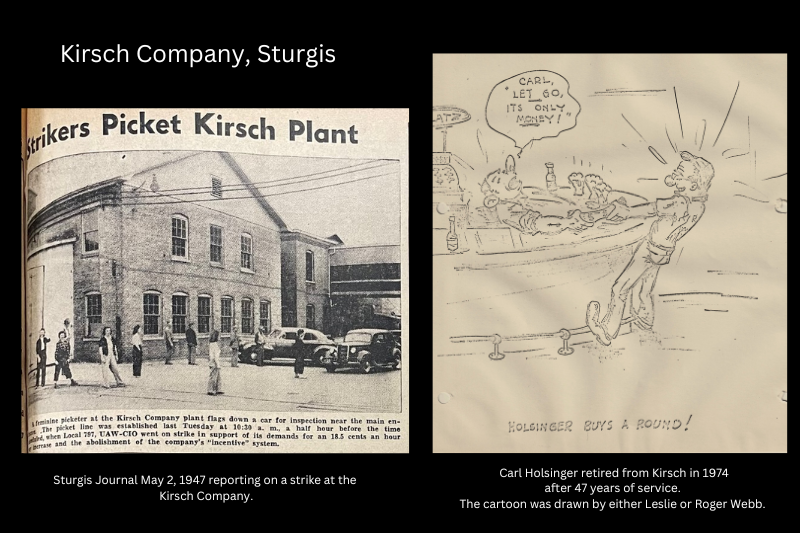But A Good Place To Work
Kirsch Company is a Sturgis legend that many locals well remember. While there are stacks of info on C.W. Kirsch and the early days, there are more stacks of information about the next 90 years.
Some former employees donated extensive collections including Don Penick. His name is written on many folders, books and documents spanning several decades. I asked around and according to Jackie Persing, also a former Kirsch employee, “He was brilliant.”

Penick started out as a tool and die maker and 45 years later retired as a senior design engineer. Apparently he didn’t throw much away but his information was very orderly. He had inter-office memos spanning the 1970s-1990s, notification on management personnel moving around within the organization, leaving and retiring. I started to scan the pages and soon noticed that many people worked for Kirsch for decades as did Penick.
Here are some Kirsch lifers.
Retired in the 1970s: Carl Holsinger – 47 years; Robert Pfeiffer – 41 years; Glen Smith – 36 years; Chuck Cross – 38 years; Paul Eckert – 43 years.
Retired in the 1980s: Robert Addison – 25 years, Dorothy McDonald – 33 years.
Retired in the 1990s: George King – 39 years; Paul Fennell – 44 years; Harold Mapes – 35 years; Charles Lytle – 40 years; Dean Mead – 46 years; Roger Wolf – 40 years; Sheldon Fieberkorn – 43 years; Bob Keasey – 30 years.
If I read through the decades of the Kirsch Courier I would probably find more long-term staff among the rank and file.
All that makes it sound like Kirsch was a happy, happy place to work. Of the former employees I’ve talked to, that’s how they remember it but other things also show up in the records.
For instance, I found the history of the U.A.W. and Local 797 which started in 1941, back in the “good old days” long before the company was sold several times.
“Local 797 History” cites “poor working conditions and lack of job security, along with the need for more money” as reasons the U.A.W. Local 797 was chartered on March 19, 1941.
In 1946, the union went on strike demanding a 32 ½ cent per hour raise and no difference in pay for men and women working on the same job. The strike started on April 30, 1946 and lasted six weeks. They settled for an 18 1⁄2 cent per hour pay increase, the same wages for men and women and a few other things.
From 1947-1953, the union brought in additional improvements including wage increases, paid holidays, better insurance and vacation time based on seniority.
Recently, Diane Webb Schrock stopped by the museum to see if we were interested in her father’s, Roger Webb, Korean War uniform. In the course of our conversation, Diane mentioned her dad was an artist.
“Where did he work?” I asked.
“At Kirsch for years,” she said
I grabbed a binder full of cartoons. It was haunting me. Nothing was signed, all were inside jokes and clearly Kirsch related. Immediately she recognized it as her dad’s and Uncle Leslie Webb’s work – both Kirsch employees.
Imagine my delight – identification!
A few days later, she came back with her sister, Christine Webb Morrow. Both remembered Kirsch Company being like a family. They lived near the factory and when workers were on strike, they remembered taking dinner over for the picketers – a good memory. It was clearly another strike as neither were born yet in 1946.
All these buried facts point to a former era when many employees stayed for life but not without a tug-of-war between management and labor.
Was Kirsch a good place to work? Apparently it was very good except perhaps the last few years – I found a lot of angst in the late 1990s.
Was it perfect? Of course not. Nothing is perfect and it’s important not to close the curtains to hide that view of history.




